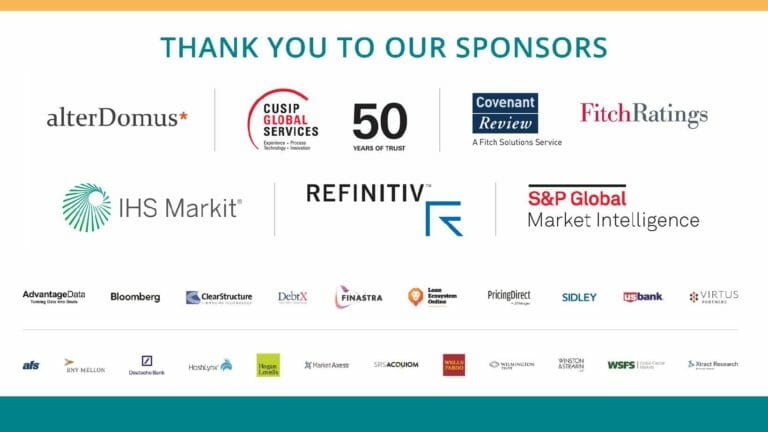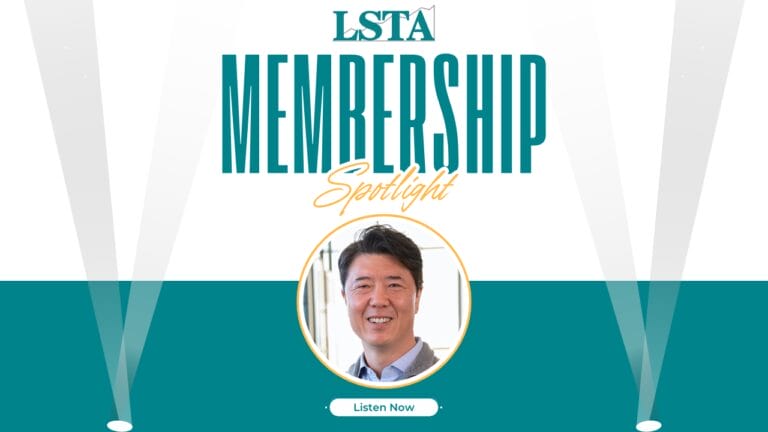October 31, 2019 - On Wednesday, October 30, 2019, the LSTA hosted its 24th Annual Loan Market Conference. In case you weren’t one of the lucky 1,200 attendees, we are providing a short summary in the LSTA Newsletter today, with links to the presentations and charts. Of course, we hope you can join us in person next year!
The conference featured a series of sessions divided roughly into i) what’s happening in the markets today, ii) actions being taken to defend the loan market from unjustified criticism, iii) efforts to improve the market, and iv) efforts to prepare for potentially the biggest change in the loan market’s history. We recap each theme below.
What’s happening in the market today? LSTA Executive Director Lee Shaiman discussed the most pressing issues and threats to the syndicated loan market with the five members of the LSTA Executive Committee. Key issues included (sometimes inaccurate) negative press on investor decisions to allocate to leveraged loans—there has been some impact on funds flows—and growing competition between direct lending and the broadly syndicated market. The Committee sees signs of tightening credit conditions but they have not reached a point signaling a meaningful increase in credit losses above market expectations. So what’s needed? Education and the provision of data and factual analysis regarding loans to investors, regulators and legislators is a critical to sound decision making.
So where is credit risk, after all? LSTA EVP Ted Basta and his panel flagged i) the longevity of the current credit cycle and ii) the subsequent record percentage of lower rated credits in today’s market. Panelists identified other risk indicators such as Fitch’s Loans of Concern List climbing above $100 billion in September and a downgrade/upgrade ratio that just increased to almost 5:1. But panelists were quick to point out that the current cycle still has legs and that conditions remain accommodative given demand from investors. Finally, the panel agreed that defaults should begin to pick up in 2020, with the estimated rate rising to 3% by year-end 2020.
And how is the market adjusting to credit risk? Mr. Basta’s market panel added that that despite returning over 6% on the year, loan market returns trail other major asset classes. Panelists agreed that a 10-month decline in rates coupled with a softer credit outlook has kept the secondary market range bound for most of the year. Most recently, volatility has been on the rise as i) the secondary loan market has bifurcated by liquidity/quality and ii) lenders repriced risk. The risk-off trade has been a crowded one, given that market composition is largely comprised of CLOs (which are very rules-oriented) and SMAs (which are more highly focused on high-quality credits).
How do documents contribute (or not) to credit risk? LSTA EVP Bridget Marsh’s legal panel discussed just this. After years of focusing on deal terms becoming too aggressive or too borrower-friendly, depending on one’s perspective, the legal experts debated liability management and the types of tools available in a restructuring toolkit. Buybacks, uptier exchanges, and JCrew /Chewy maneuvers may all be on the table for a distressed borrower. There was agreement, however, that it’s too early for the LSTA to standardize credit agreement language to address net short debt activists because the language continues to evolve, with definitions such as affiliates, net short, and whether to carveout all banks still in flux.
Finally, some reportedly aggressive deals have raised the perennial – and now pressing! – issue of whether it would really be “The End of the World as we Know it” if term loan Bs became subject to disclosure and liability provisions of the US securities laws. At a minimum, the market would change in very fundamental ways, many negative, beginning with how banks underwrite and distribute loans. The big takeaway: There are many more questions about the future than there are answers but we need to continue taking the questions very seriously. This may happen, after all.
How does one take action when all the issues cited above are reported as an indictment of the loan asset class? LSTA EVP Meredith Coffey interviewed two Washington (and New York) veterans to discuss how partisan politics affect lawmakers, regulators and the loan market. The lessons were: First, headlines do matter. Second, it is critical to counteract false impressions by engaging frequently, armed with well-documented facts and analysis, not with speculation and bloviation. After all, loan market critics are speaking loudly and frequently in Washington, and “hiding under our desks” isn’t a sound strategy. Finally, will the situation get better? Well, it is political season and if the loan market stumbles, it could be political fodder. However, if the loan market can self-discipline, then it is less likely to stumble.
So how does the market self-discipline? It’s not easy, but progress on Primary Delayed Compensation may be an example. As LSTA EVP Ellen Hefferan and her panel discussed, a key initiative of the LSTA over the past year has been to implement Primary Delayed Compensation which should increase liquidity and produce faster settlement times for both primary allocations and secondary trades. Primary Delayed Comp will officially kick off as primary allocations are communicated to the Buyers beginning January 1, 2020 as long as the Seller and the Administrative Agent are the same or affiliated entities. There is a lot for the market to learn to improve: All loan market participants must understand the rules and mechanics around Pre-Trigger and Post-Trigger Allocations and Pre-Trigger, Post-Trigger, Early Day and regular Secondary Trades. Each will have different “Ready Dates” by which the Buyer has to meet requirements and varying Commencement Dates for when Delayed Comp will begin to accrue. Sellers have new responsibilities and timelines to meet. Primary Confirms and respective Standard Terms and Conditions have been added; Par and Near Par Standard Terms and Conditions have been revised. Electronic Settlement Platforms will be impacted and functionality is being built and will be tested soon. Long story short: Self-discipline is hard – but important.
Amidst all this cyclical noise, how do we address one of the biggest secular loan market changes ever? LIBOR is the reference rate for some $200 trillion of USD contracts, including $4 trillion of loans and nearly $700 billion of CLOs. So, how do we adapt to its cessation in early 2022? The LSTA, an ARRC member and co-chair of the ARRC’s Business Loans Working Group, is tackling this hard and making material progress – but there is a lot left to do! In the End of LIBOR panel, LSTA EVP Meredith Coffey level set with market leaders in this space. First, to be clear, LIBOR almost definitely will end shortly after the end of 2021 and SOFR is likely to be the replacement in the syndicated loan market. So how do we kick our LIBOR habit? First, we get good executable fallback language into credit agreements. This means shifting from the “amendment” approach to the “hardwired” approach as soon as is feasible. What makes it feasible? 1) Knowing the economics of the switch and 2) knowing that your systems will be able to operationalize SOFR. Second, we need to actually start doing new loans based on SOFR (and start migrating away from doing loans based on LIBOR). This actually isn’t impossible – there have been $300 billion of SOFR FRNs.
Of course, in order to do SOFR-based loans, we need a SOFR-based credit agreement. Conveniently, we have a conceptual one coming! LSTA SVP Tess Virmani and her panel of legal eagles took a look into the future to understand both the credit agreement and loan structuring implications for a loan that references SOFR compounded in arrears and the operational advantages of hardwired fallback language. The session focused on the calculation of the compounded rate, the conventions that may be necessary to allow the interest to be determined before the end of the interest period and the information pieces, like published averages and spread adjustments, that may make loan market participants comfortable with hardwired fallback language.
And, of course, the market cannot switch to SOFR loans unless loan systems can operationalize SOFR. To that end, LSTA EVPs Ellen Hefferan and Meredith Coffey co-led a “SOFR Operationalization” panel. To wit, there are four SOFRs that need to be operationalized: Forward Looking Term SOFR and SOFR Compounded in Advance (the easy ones) and Simple Daily SOFR in Arrears and SOFR Compounded in Arrears (the more challenging ones). Inasmuch as we may end up in a SOFR Compounded in Arrears world, it is critical that systems can consume it. Happily(ish), the ARRC’s BLWG (co-led by the LSTA) is working hard to define SOFR Conventions and help vendors and lenders get their SOFR systems up and running.
And finally, a thank you! The LSTA would like to thank our 1,200 attendees and, in particular, the 37 sponsors and exhibitors that made the conference doable. Specifically, thank you to Alter Domus, S&P/LCD, S&P CUSIP, IHS Markit, Refinitiv, Fitch Ratings, Advantage Data, Loan Ecosystem, Bloomberg, U.S. Bank, Clearstructure Financial, Virtus Trade Settlement, DebtXchange, Sidely Austin, Finastra, Pricing Direct by JPM, Wells Fargo, Winston & Strawn, Wilmington Trust, Wilmington Savings Fund Society, Moody’s, MarketAxess, Hogan Lovells, BNY Mellon, Deutsche Bank, Xtract Research, SRS Acquiom, Hashlynx, AFS, Seward & Kissel, Allen & Overy, Katten Muchin, Alston & Bird, Kirkland & Ellis, Sia Partners, Alcentra, DLA Piper, Wilmer Hale, and Proskauer Rose. Thank you all!







